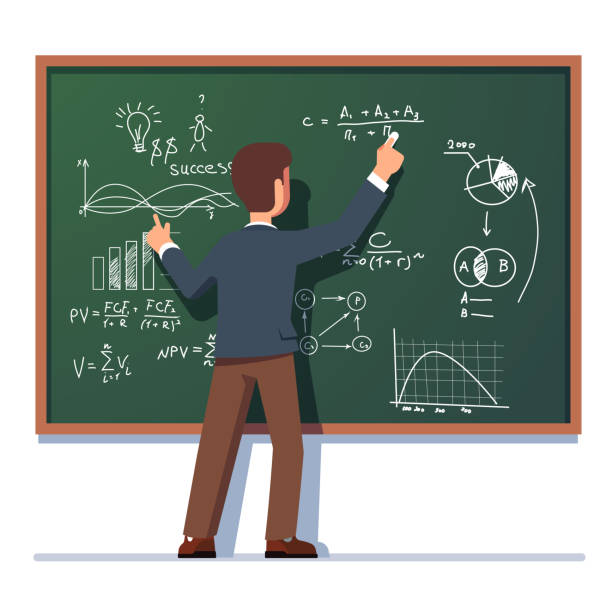The methods experienced math teachers use to build strong problem-solving skills
Wiki Article
Achieving Enterprise Quality: Comprehending Market Standards and Strategic Leadership for Mathematics Faculty
Accomplishing venture quality in maths education and learning necessitates a careful assessment of industry requirements and the duty of strategic leadership. Mathematics faculty must understand exactly how these criteria shape educational program and mentor approaches. In addition, efficient leadership can drive collaboration and specialist growth amongst educators. This complex strategy questions about the sensible implications for trainees' career readiness. What methods can faculty embrace to link the space between education and sector needs?The Value of Sector Standards in Mathematics Education And Learning
In the domain name of mathematics education, adhering to sector standards is vital for ensuring that programs properly prepare pupils for real-world applications. Industry standards provide a structure that straightens educational end results with the abilities required in different professions. By integrating these criteria, math programs can enhance their relevance and rigor, thereby improving pupil interaction and discovering outcomes.
Strategic Leadership: Specifying Roles and Duties
Efficient strategic management within maths faculty requires a clear meaning of responsibilities and functions to assure suitable working and alignment with institutional goals. Leadership frameworks need to be developed to mark tasks amongst professors members, managers, and assistance team, making certain that each specific comprehends their payments toward cumulative goals. Faculty leaders need to grow an environment that promotes collaboration and responsibility, allowing employee to engage successfully in curriculum growth and evaluation procedures.In addition, tactical leaders must prioritize continuous expert growth, making certain that professors members are well-appointed to fulfill the evolving demands of maths education and learning. This includes not just lining up private functions with institutional priorities but also fostering a culture of continual renovation and advancement. By clearly defining functions, critical management can enhance communication, streamline decision-making procedures, and ultimately contribute to a much more cohesive and reliable maths faculty, positioned to satisfy the challenges of contemporary education and learning.
Ideal Practices for Enhancing Mentor and Understanding
In the pursuit of improving training and knowing, mathematics professors can take advantage of innovative mentor methods that engage trainees successfully. Implementing collaborative knowing atmospheres promotes team effort and vital reasoning abilities amongst learners. These best methods are vital for producing a vibrant academic experience that advertises much deeper understanding of mathematical principles.Cutting-edge Mentor Techniques
While typical techniques of training have their area, innovative teaching approaches are vital for boosting interaction and understanding amongst maths faculty and their students. Methods such as turned class and problem-based knowing motivate energetic involvement, permitting students to take ownership of their understanding. Integrating technology, such as interactive simulations and on-line partnership tools, even more supports diverse discovering designs and promotes critical thinking. In addition, the use of real-world applications in lessons assists trainees link mathematical concepts to day-to-day life, making the topic much more relevant and attractive. Professors participants that accept these techniques can create a vibrant discovering environment that not only boosts understanding but also motivates a long-lasting interest for mathematics. Embracing cutting-edge methods ultimately results in higher levels of trainee accomplishment.
Collaborative Knowing Atmospheres
Building on the cutting-edge teaching approaches formerly gone over, joint understanding environments play a crucial duty in boosting the educational experience for mathematics faculty and their students. These atmospheres urge energetic involvement and foster a feeling of community, enabling trainees to learn from each other and create vital thinking skills. Ideal techniques consist of structured team work, peer tutoring, and project-based knowing, which promote partnership and shared obligation for finding out outcomes. Faculty needs to assist in discussions and provide guidance while allowing students to discover ideas collectively. Furthermore, integrating modern technology can enhance collaboration by supplying systems for communication and source sharing. Ultimately, collective understanding atmospheres encourage pupils to take possession of their education and cultivate a much deeper understanding of mathematical principles with teamwork and interaction.
Aligning Faculty Goals With Institutional Purposes
Lining up professors objectives with institutional goals is important for promoting a cohesive educational environment that improves both training performance and student success. When professor comprehend and accept the broader goal of their institution, their mentor approaches can be customized to sustain these goals. This positioning guarantees that professors are not just satisfying department assumptions yet also adding to the overarching goals of the institution, such as boosting student engagement and scholastic efficiency.To attain this placement, regular interaction in between faculty and management is essential. Workshops and collective conferences can help with discussions on institutional top priorities and just how faculty can incorporate these right into their educational program. Furthermore, efficiency evaluations can be created to show these aligned goals, urging faculty to introduce in their teaching approaches. Inevitably, when professors goals resonate with institutional objectives, they grow a much more unified strategy to education and learning, benefiting both students and teachers alike.
Cultivating a Culture of Continual Improvement
Promoting a Full Article society of constant renovation within maths professors is necessary for improving both instructional top quality and student end results. This entails developing an atmosphere where professor are encouraged to consistently analyze their teaching practices and look for comments. Expert development chances ought to be readily available, enabling straight from the source instructors to explore new pedagogical techniques and incorporate evidence-based techniques into their educational program.Additionally, cooperation among faculty is important; sharing insights and experiences can result in cutting-edge services and enhanced teaching methodologies. Institutions must apply methodical analysis processes, allowing faculty to review their performance and recognize locations for growth.
Recognizing and commemorating achievements, no issue exactly how little, reinforces the dedication to improvement. By embedding continual enhancement right into the professors society, math divisions can improve their total effectiveness, eventually profiting both teachers and students in the quest of scholastic excellence.
Cutting-edge Strategies to Mathematics Program Advancement
Countless ingenious approaches can change maths program advancement, making it a lot more responsive to the advancing instructional landscape. experienced math teachers. One effective method includes incorporating modern technology, such as on the internet knowing systems and interactive software, to improve trainee interaction and accessibility. This change permits for a mixed learning environment, dealing with varied knowing designsTaking on a project-based discovering structure motivates joint analytical and real-world application of mathematical concepts. Faculty can also highlight interdisciplinary connections, showing exactly how maths converges with areas like science, art, and design, fostering an extra all natural instructional experience.
Regular feedback from pupils and industry stakeholders can direct curriculum modifications, making certain relevance and roughness. Furthermore, using expert growth possibilities for faculty can promote innovative teaching techniques and maintain instructors educated of the current fads. With these strategies, math programs can cultivate a dynamic knowing atmosphere that prepares pupils for future difficulties and professions.
Regularly Asked Concerns
How Can Professors Measure the Influence of Industry Standards on Pupil Outcomes?
Professors can gauge the influence of market requirements on student results by analyzing analysis outcomes, tracking work prices, obtaining employer responses, and conducting longitudinal researches to contrast student efficiency prior to and after implementing the criteria.What Resources Are Available for Professional Development in Mathematics Education?
Various sources for specialist development in maths education include online programs, workshops, webinars, professional organizations, meetings, and peer partnership opportunities. These systems assist in ability improvement, cutting-edge training methods, and reliable integration of innovation into maths guideline.Exactly How Do Industry Standards Vary Across Various Geographical Areas?
Market criteria vary substantially throughout geographical regions as a result of factors like governmental policies, academic top priorities, and social influences. These disparities can affect curriculum growth, training techniques, and the execution of assessment methods in maths education.What Duty Does Modern Technology Play in Getting Enterprise Quality in Mathematics?
Technology enhances enterprise quality in maths by streamlining processes, enabling information evaluation, promoting cooperation, and providing access to sources. It equips students and instructors alike, promoting ingenious teaching methods and improving total educational end results in the field.How Can Professors Effectively Collaborate With Sector Partners?

In the search of boosting teaching and discovering, math faculty can profit from innovative teaching methods that engage students properly. While conventional techniques of teaching have their area, innovative mentor methods are important for improving interaction and understanding amongst mathematics faculty and their pupils. Building on the cutting-edge mentor methods previously talked about, joint knowing environments play a pivotal role in improving the educational experience for maths faculty and their pupils. Aligning professors objectives with institutional goals is vital for fostering a natural educational setting that boosts both training effectiveness and pupil success. Cultivating a culture of continual renovation within mathematics professors is important for enhancing both instructional top quality and pupil outcomes.
Report this wiki page